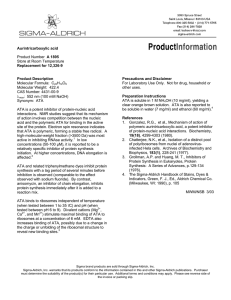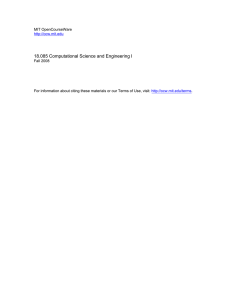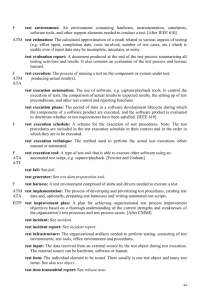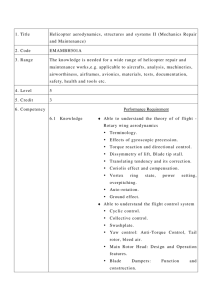1. Title Aeroplane aerodynamics, structures and systems I 2. Code
advertisement
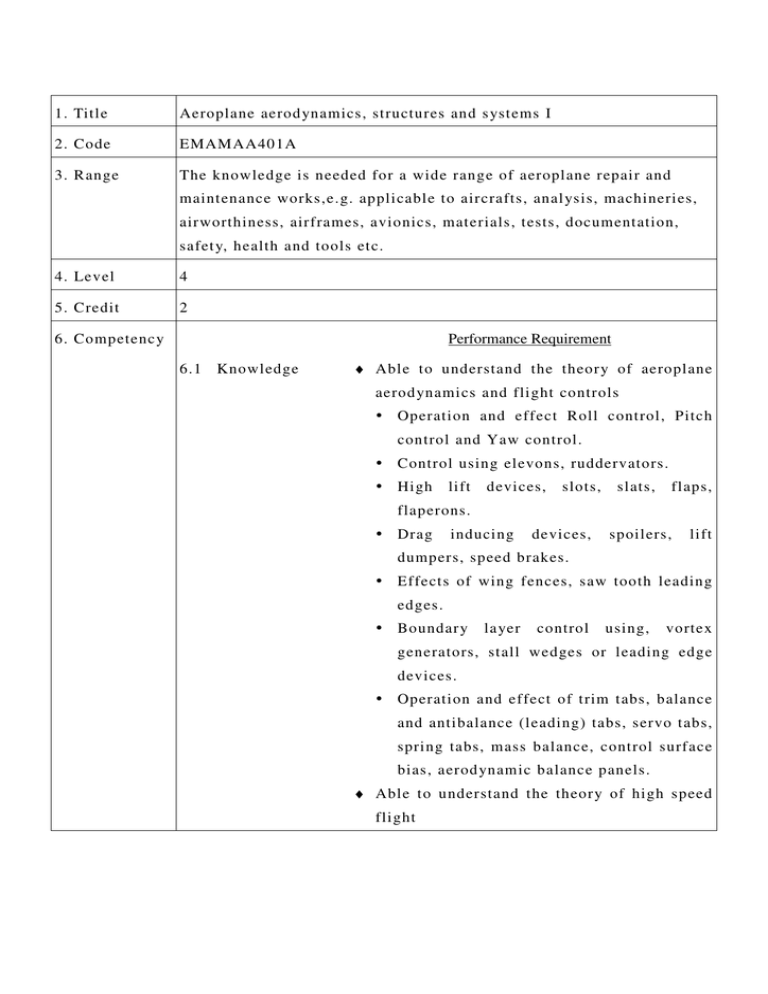
1. Title Aeroplane aerod ynamics, structures and s ystems I 2. Code EMAMAA401A 3. Range The knowledge is needed for a wide range of aeroplane repair and maintenance works,e.g. applicable to aircrafts, anal ysis, machineries, airworthiness, airframes, avionics, materials, tests, documentation, safet y, health and tools etc. 4. Level 4 5. Credit 2 6. Competency Performance Requirement 6.1 Knowledge ♦ Able to understand the theory of aeroplane aerod ynamics and flight controls Operation and effect Roll control, Pitch control and Yaw control. Control using elevons, ruddervators. High lift devices, slots, slats, flaps, flaperons. Drag inducing devices, spoilers, lift dumpers, speed brakes. Effects of wing fences, saw tooth leading edges. Boundary layer control using, vortex generators, stall wedges or leading edge devices. Operation and effect of trim tabs, balance and antibalance (leading) tabs, servo tabs, spring tabs, mass balance, control surface bias, aerod ynamic balance panels. ♦ Able to understand the theory of high speed flight ♦ Able to understand the general concept of the airframe structures Airworthiness requirements for structural strength. Construction methods of: stressed skin fuselage, formers, stringers, longerons, bulkheads, frames, doublers, struts, ties, beams, floor structures, reinforcement, methods of skinning, anti-corrosive protection, wing, empennage and engine attachments. ♦ Able to understand the aeroplanes airframe structures Fuselage (ATA 52/53/56) Wings (ATA 57) Stabilisers (ATA 55) Flight control surfaces (ATA 55/57) Nacelles/P ylons (ATA 54) ♦ Able to understand the air conditioning and cabin pressurisation (ATA 21) Air suppl y Air conditioning Pressurisation Safet y and warning devices ♦ Able to understand the Instruments/Avionic Systems Instrument S ystems (ATA 31) Avionic S ystems ♦ Able to understand the electrical power (ATA 24) Batteries Installation and Operation. DC power generation. AC power generation. Emergency power generation. Voltage regulation. Power distribution. Inverters, transformers, rectifiers. Circuit protection. External / Ground power. ♦ Able to understand the equipment and furnishings (ATA 25) Emergency equipment requirements. Cabin lay-out. ♦ Able to understand the fire protection (ATA 26) Fire and smoke detection and warning s ystems. Fire extinguishing s ystems. System tests. ♦ Able to understand the flight controls (ATA 27) Primary controls: aileron, elevator, rudder, spoiler. Trim control. Active load control. High lift devices. Lift dump, speed brakes. System operation: manual, h ydraulic, pneumatic, electrical, fl y-b y-wire. Artificial feel, Yaw damper, Mach trim, rudder limiter, gust locks. Balancing and rigging. Stall protection s ystem. ♦ Able to understand the fuel s ystems (ATA 28) System lay-out. Fuel tanks. Suppl y s ystems. Dumping, venting and draining. Cross-feed and transfer, Indications and warnings. Refuelling and defuelling. Longitudinal balance fuel s ystems. ♦ Able to understand the h ydraulic power (ATA 29) System lay-out. Hydraulic fluids. Hydraulic reservoirs and accumulators. Pressure generation: electric, mechanical, pneumatic. Emergency pressure generation. Pressure Control. Power distribution. Indication and warning s ystems. Interface with other s ystems. ♦ Able to understand the ice and rain protection (ATA 30) Ice formation, classification and detection. Anti-icing s ystems: electrical, hot air and chemical. De-icing s ystems: electrical, pneumatic and chemical. Rain repellant and removal. Probe and drain heating. ♦ Able to understand the landing gear (ATA 32) Construction, shock absorbing. Extension and retraction s ystems: normal and emergency. Indications and warning. Wheels, brakes, antiskid and autobraking. Tyres. Steering. ♦ Able to understand the lights s ystem (ATA 33) External: navigation, anti-collision, landing, taxiing, ice. Internal: cabin, cockpit, cargo. Emergency. ♦ Able to understand the ox ygen s ystem (ATA 35) System lay-out: cockpit, cabin. Sources, storage, charging and distribution. Suppl y regulation. Indications and warnings. ♦ Able to understand the pneumatic/vacuum (ATA 36) System lay-out. Sources: engine / APU, compressors, reservoirs, ground suppl y. Pressure control. Distribution. Indications and warnings. Interfaces with other s ystems. ♦ Able to understand the Water/Waste (ATA 38) Water s ystem lay-out, suppl y, distribution, servicing and draining. Toilet s ystem lay-out, servicing. Corrosion aspects. flushing and ♦ Able to understand the On Board Maintenance S ystems (ATA 45) Central maintenance computers. Data loading s ystem. Electronic library s ystem. Printing. Structure monitoring (damage tolerance monitoring). 6.2 Theoretical and ♦ Able to appl y the following knowledge in the practical aircraft maintenance. aspects Airworthiness requirements for structural strength Emergency equipment requirements Landing gear (ATA 32) Lights (ATA 33) Water/Waste (ATA 38) 6.3 Professional approach ♦ Able to understand the principal elements of the subjects. ♦ Able to understand the general knowledge of the theoretical and practical aspects of the following subjects. Airworthiness requirements for structural strength Emergency equipment requirements Landing gear (ATA 32) Lights (ATA 33) Water/Waste (ATA 38) ♦ Able to appl y the knowledge in the aircraft maintenance task. 7. Assessment The integral outcomes requirement of this UoC are: Criteria (i) Able to understand the theoretical fundamentals of the subjects. (ii) Able to give a general description of the subjects using, as appropriate, t ypical examples. (iii) Able to use mathematical formulae in conjunction with ph ysical laws describing the subjects. (iv) Able to read and understand sketches, drawings and schematics describing the subjects. (v) Able to appl y the knowledge in a practical manner using detailed procedures. 8. Remarks Ref: HKAR-66 Module 11: Aeroplane aerod ynamics, structures and s ystems
